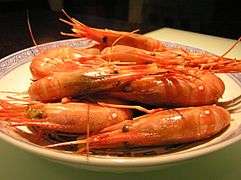Camaron rebosado

Camaron rebosado (battered shrimp) is a deep-fried battered shrimp dish in Philippine cuisine typically served with sweet and sour sauce. It is similar to Japanese tempura,[1][2] although tempura uses a lighter batter. It is a staple food in Philippine cuisine.[3] Camaron rebosado may be consumed by people who live near ponds that have significant amounts of shrimp in them.[4]
Etymology
Camaron rebosado has a Spanish name, but the dish actually originated in China.[3] This is because the Spanish colonization of the Philippines (1521–1898) involved the Hispanicization of many aspects of Filipino culture, and especially the art, names, and cuisines of the Chinese Filipinos.[3] It has been described as "a Filipino dish with a Spanish name, but with a Chinese style of preparation."[5]
Preparation
The shrimp may be sliced and formed into a butterfly shape in the preparation of camaron rebosado,[6] and the tail may be removed before frying.[7] The shrimp is then battered, fried in hot oil and traditionally served with sweet and sour sauce (agre dulce).[4][8] The sauce may be poured atop the cooked shrimp or served as a dipping sauce.[9] The batter may include baking powder and additional ingredients such as egg whites and corn starch.[6][5] It may also be prepared by dipping the shrimp in an egg wash, coating them with bread crumbs and then frying them,[4] or by just using the flour and egg and then frying.[10] The dish may also be accompanied with lemon juice, soy sauce and garlic-infused mayonnaise as condiments.[2][3]
A marinade may be used in the dish's preparation, in which the shrimp are soaked in a mixture of white wine, garlic, salt and pepper.[6]
Variations
Camaron rebosado con jamon is a variation of the dish that includes ham wrapped around the shrimp in its preparation.[lower-alpha 1][lower-alpha 2][12] Camaron rebosado con jamon has been described as a classic dish in the Binondo district of Manila, the city's Chinatown.[13]
See also
- Fried prawn
- List of deep fried foods
- List of Philippine dishes
- List of seafood dishes
- List of shrimp dishes
Notes
References
- ↑ Fernandez, Doreen; Edilberto N. Alegre (1988). Sarap: Essays on Philippine food. Mr. & Ms. Publishing. p. 145. ISBN 978-971-91137-0-6.
- 1 2 Alejandro, R.G. (1985). The Philippine Cookbook. A Perigee book. Putnam. p. 30. ISBN 978-0-399-51144-8.
- 1 2 3 4 Garcia, M.; Tettoni, L. (2012). Filipino Cookbook: 85 Homestyle Recipes to Delight Your Family and Friends. Tuttle Publishing. p. pt86-88. ISBN 978-1-4629-0528-7.
- 1 2 3 Dagoon, E.A. Culinary Arts i. Rex Bookstore, Inc. p. 141. ISBN 978-971-23-2603-5.
- 1 2 Diego, A. (2011). Step by Step Cooking Filipino: Delightful Ideas for Everyday Meals. Step-by-step cooking. Marshall Cavendish International (Asia) Private Limited. p. 82. ISBN 978-981-4435-15-4.
- 1 2 3 Alcuaz, N.T. (2005). Banana Leaves: Filipino Cooking and Much More. Trafford Publishing. p. pt124. ISBN 978-1-4120-5378-5.
- ↑ Basbas, E.A. Learning & Living in the 21st Century i for H.s.' 2007 Ed. Rex Bookstore, Inc. p. 151. ISBN 978-971-23-4784-9.
- ↑ Alejandro, R.; Tettoni, L. (2012). Authentic Recipes from the Philippines. Tuttle Publishing. p. pt64. ISBN 978-1-4629-0533-1.
- ↑ Olizon-Chikiamco, N. (2003). Homestyle Filipino Cooking. Periplus mini cookbooks. Tuttle Publishing. p. pt54. ISBN 978-1-4629-1392-3.
- ↑ Fernando, E.A. New Perspectives in English One' 2005 Ed. Rex Bookstore, Inc. p. 127. ISBN 978-971-23-4249-3.
- 1 2 Reyes, C.; Fernando, G.C. (1991). Kusina: what's cooking in the Philippines. Kusina: What's Cooking in the Philippines. Larawan Books. p. 165.
- ↑ Panlilio, E.E. (2003). Comfort Food. Anvil Pub. p. 214. ISBN 978-971-27-1407-8.
- ↑ Perez, Irene C. (February 16, 2012). "Camaron Rebosado con Jamon and other 'mestizong Intsik' favorites". Philippine Daily Inquirer. Retrieved April 7, 2016.
External links
-
 Media related to Camaron rebosado at Wikimedia Commons
Media related to Camaron rebosado at Wikimedia Commons

